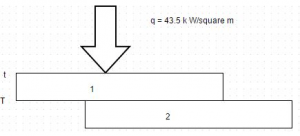This set of Heat Transfer Interview Questions & Answers focuses on “General Heat Conduction Equation”.
1. From the concept of kinetic theory, mean travel velocity of the gas molecules is prescribed by the relation
a) V = (3M/GT) 1/2
b) V = (3GT/M) 1/2
c) V = (6T/GM) 1/2
d) V = (3GT/2M) 1/2
View Answer
Explanation: Heat transfer by conduction in gases occurs through transport of the kinetic energy of molecular motion resulting from the random movement and collisions of the molecules.
Where, G = Universal gas constant
M = Molecular weight of the gas
T = Absolute temperature.
2. Low temperature insulation are used when the enclosure is at a temperature lower than the ambient temperature. Which one of the following is not a low temperature insulation?
a) Asbestos
b) Cork
c) Cattle hair
d) Slag wool
View Answer
Explanation: Asbestos is a high temperature insulation which is used when it is desired to prevent an enclosure at a temperature higher than the ambient from losing heat to its surroundings.
3. The value of Lorenz number in 10-8 W ohms/K2 is
a) 2.02
b) 2.35
c) 2.56
d) 2.45
View Answer
Explanation: Lorenz no. = k/α T
4. For liquids, thermal conductivity is governed by the relation
a) k = A c p p7/3/M1/3
b) k = 2A c p p4/3/M2/3
c) k = A c p p4/3/M1/3
d) k = A c p p8/3/M1/3
View Answer
Explanation: Area doesn’t depends on the nature of liquid but on the quantity (Ac p) is nearly constant for all liquids. Where,
CP = Specific heat at constant pressure
M = Molecular weight of the gas
p = Mass density
A = Area.
5. Consider the following parameters
(i) Composition
(ii) Density
(iii) Porosity
(iv) Structure
Then, thermal conductivity of glass wool varies from sample to sample because of variation is
a) i and ii
b) i, ii, iii and iv
c) i and iii
d) i, ii and iii
View Answer
Explanation: There is a variation due to all the above options.
6. The thermal conductivity and the electrical conductivity of a metal at absolute temperature are related as
a) k/σ T
b) k/σ
c) k σ/T
d) k/T
View Answer
Explanation: It is defined as the ratio of thermal conductivity to the product of electrical conductivity and temperature.
7. The relation Ϫ2 t =0 is referred to as
a) Poisson’s equation
b) Fourier heat conduction equation
c) Solution for transient conduction
d) Laplace equation
View Answer
Explanation: In the absence of internal heat generation or release of energy within the body, equation reduces to Laplace equation.
8. The unit of thermal diffusivity is
a) m2/hr-K
b) kcal/m2-hr
c) m2/hr
d) m/hr-K
View Answer
Explanation: The quantity α = k/pc is called thermal diffusivity.
9. To effect a bond between two metal plates, 2.5 cm and 15 cm thick, heat is uniformly applied through the thinner plate by a radiant heat source. The bonding must be held at 320 K for a short time. When the heat source is adjusted to have a steady value of 43.5 k W/m2, a thermocouple installed on the side of the thinner plate next to source indicates a temperature of 345 K. Calculate the temperature gradient for heat conduction through thinner plate. In the diagram, the upper plate is 2.5 cm thick while the lower is 15 cm thick.

a) – 1000 degree Celsius/m
b) – 2000 degree Celsius/m
c) – 3000 degree Celsius/m
d) – 4000 degree Celsius/m
View Answer
Explanation: Temperature gradient = d t/d x = – 1000 degree Celsius/m. Also, q/A = – k (t2– t 1)/δ.
10. The diffusion equations
Ɏ2t + q g = (1/α) (d t/d r)
Governs the temperature distribution under unsteady heat flow through a homogeneous and isotropic material. The Fourier equation follows from this expression when
a) Temperature doesn’t depends on time
b) There is no internal heat generation
c) Steady state conditions prevail
d) There is no internal heat generation but unsteady state condition prevails
View Answer
Explanation: In unsteady state condition, there is no internal heat generation.
Sanfoundry Global Education & Learning Series – Heat Transfer.
To practice all areas of Heat Transfer for interviews, here is complete set of 1000+ Multiple Choice Questions and Answers.
If you find a mistake in question / option / answer, kindly take a screenshot and email to [email protected]
- Check Chemical Engineering Books
- Apply for Chemical Engineering Internship
- Practice Chemical Engineering MCQs
- Practice Mechanical Engineering MCQs
- Check Heat Transfer Books
